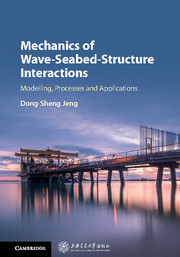Book contents
- Frontmatter
- Contents
- Preface
- 1 Overview
- 2 Basic Seabed Mechanisms
- 3 Soil Response in Marine Sediments under Combined Loading of Waves and Currents
- 4 Integrated Model of Wave-Seabed Interactions around Caisson-Type Breakwaters
- 5 Mechanics of Wave-Seabed-Pipeline Interactions
- 6 Three-Dimensional Model of Wave-Seabed Interactions around Breakwater Heads
- 7 Seabed Instability around Offshore Wind Turbine Foundations
- 8 Physical Modelling: One-Dimensional Compressive Tests
- Appendix A Analytical Solution for a Seabed of Finite Thickness (Hsu & Jeng 994)
- Appendix B Derivation of u–p Approximation (Jeng et al. 1999)
- Appendix C Derivation of u–U Approximation (Cha et al. 2002)
- Appendix D Mathematical Derivations of Analytical Solutions for Residual Soil Response (Jeng et al. 2007)
- Appendix E Mathematical Model of the Two-Layered Viscous Fluid System (Liu et al. 2009)
- References
- Author Index
- Subject Index
4 - Integrated Model of Wave-Seabed Interactions around Caisson-Type Breakwaters
Published online by Cambridge University Press: 28 April 2018
- Frontmatter
- Contents
- Preface
- 1 Overview
- 2 Basic Seabed Mechanisms
- 3 Soil Response in Marine Sediments under Combined Loading of Waves and Currents
- 4 Integrated Model of Wave-Seabed Interactions around Caisson-Type Breakwaters
- 5 Mechanics of Wave-Seabed-Pipeline Interactions
- 6 Three-Dimensional Model of Wave-Seabed Interactions around Breakwater Heads
- 7 Seabed Instability around Offshore Wind Turbine Foundations
- 8 Physical Modelling: One-Dimensional Compressive Tests
- Appendix A Analytical Solution for a Seabed of Finite Thickness (Hsu & Jeng 994)
- Appendix B Derivation of u–p Approximation (Jeng et al. 1999)
- Appendix C Derivation of u–U Approximation (Cha et al. 2002)
- Appendix D Mathematical Derivations of Analytical Solutions for Residual Soil Response (Jeng et al. 2007)
- Appendix E Mathematical Model of the Two-Layered Viscous Fluid System (Liu et al. 2009)
- References
- Author Index
- Subject Index
Summary
Introduction
Breakwaters are commonly adopted to protect and enhance the utility of coastlines. For example, the total length of all breakwaters in Japan is 4,143 km – one-fifth of its coastline (Hsu, Uda & Silvester 2000). In countries such as the United Kingdom and Japan, coastline protection is a national priority. The construction of new breakwaters and the expansion of existing breakwaters involve major investment. Worldwide, the combined costs for building new breakwaters and maintaining the existing ones are on the order of tens of billions of pounds a year.
Breakwaters are vulnerable to liquefaction of the seabed foundation, a process that can often lead to significant degradations of the foundation in as little as a few years after construction and can sometimes even result in total collapse (Zen et al. 1985; Lundgren et al. 1989; Franco 1994; Zhang & Ge 1996; Sumer & Fredsøe 2002; Chung, Kim, Kang, Im & Prasad 2006). Inappropriate design or maintenance of breakwaters can lead to catastrophic coastal disaster. A recent example of coastal tragedy caused by the failure of breakwaters is that of New Orleans during Hurricane Katrina, which caused deaths and personal and economic chaos (Travis 2005).
The phenomenon of wave-seabed-structure interactions (WSSIs) has a major bearing on this issue and is central to the design of coastal structures such as breakwaters, pipelines and platforms. There have been numerous investigations of wave-seabed interactions around marine structures based on Biot's poro-elastic theory. Among these, Mase et al. (1994) developed a finite element method (FEM) numerical model to investigate wave-induced pore-water pressures and effective stresses under standing waves in a sand seabed and in the rubble-mound foundation of a composite caisson-type breakwater based on Biot's consolidation equations. Later, Mizutani & Mostafa (1998) and Mostafa et al. (1999) developed a boundary element method–FEM combination numerical model to investigate the wave-seabed-structure interaction. In their models, Poisson's equation is used to govern the irrotational wave field for an incompressible, inviscid fluid, and Biot's poro-elastic consolidation equations are used to govern the porous seabed and structures. Jeng, Cha, Lin & Hu (2001) developed a two-dimensional (2D) generalised FEM numerical model (GFEM-WSSI) to investigate the wave-induced pore pressure under a linear wave around a composite breakwater located at a finite, isotropic and homogeneous seabed.
- Type
- Chapter
- Information
- Mechanics of Wave-Seabed-Structure InteractionsModelling, Processes and Applications, pp. 129 - 176Publisher: Cambridge University PressPrint publication year: 2018



